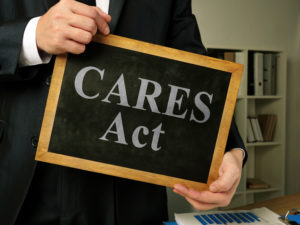Ward Law LLC is dedicated to keeping our clients informed about all things COVID-19 related. Our business is to ensure that you have all the information you need to keep your business going. In that regard, please read below for updates on the CARES Act – Paycheck Protection Program.
Paycheck Protection Program Basics

In an earlier post, we set forth some basics about the $2 trillion COVID-19 relief and stimulus package signed into law on March 27, 2020 (“CARES Act”). Within that legislation, however, there are provisions that need further exploration and explanation. To that end, this post is intended to provide some more detailed information to those who may benefit from the small business loan provisions of the CARES Act. The program is designed to provide cash to suffering small businesses quickly, with less red tape than the Small Business Administration’s existing loan programs. It is designed to incentivize business owners to keep employees on payroll by offering them loan forgiveness if certain criteria are met.
An interesting detail of the program is that the small business loans, while administered by the Small Business Administration, are initially paid by approved banks and lending institutions. The Small Business Administration has a network of 1,800 approved lenders that process small business loans. If you are interested in a program loan, you should first contact your bank to see if it is a Small Business Administration approved lender. If your bank is not an approved lender for the program, you can contact the Small Business Administration to find one.
Below is a summary outline of the CARES Act’s Paycheck Protection Program (“PPP”). Congress has allocated $349 billion for the PPP. Please note that there are additional provisions in the PPP not discussed herein, and individual business circumstances will vary.
ELIGIBILITY/BORROWER REQUIREMENTS
- Businesses and non-profits with fewer than 500 employees are generally eligible
- Certification of the following:
- “The uncertainty of the current economic conditions makes necessary the loan request to support the ongoing operation of the eligible recipient.”
- acknowledgment that the loan funds will be used to retain workers and maintain payroll or make mortgage payments, lease payments, and utility payments
- applicant does not have any other PPP loan applications pending nor received any PPP loan funds between 2.15.20 and 12.31.20
- As opposed to many other loans guaranteed by the Small Business Administration, no personal guarantee or collateral is required
AMOUNT OF LOAN AVAILABLE
- An applicant, if eligible, may obtain 2.5 times the average total monthly “payroll costs” incurred during the 1-year period before the date on which the loan is made, up to $10 million
- “Payroll Costs” is defined as payment by the employer of the following:
- salary, wages, commissions or similar compensation to employees (also includes employer payment of cash tips or equivalent to employees)
- PTO
- allowance for dismissal or separation
- group health care benefit insurance premiums
- retirement benefits
- state and local tax assessed on the compensation of employees
- “Payroll costs” does not include:
- compensation of an individual employee in excess of an annual salary of $100,000
- certain federal taxes imposed or withheld, such as Social Security and Medicare
- other less common circumstances
ALLOWABLE USE OF LOAN FUNDS
- payroll costs
- costs related to the continuation of group healthcare benefits during periods of paid sick, medical or family leave, and insurance premiums
- employee salaries, commissions, or similar compensation
- payment of interest on mortgage obligations and/or rent
- utilities
- interest on any other debt obligations that were incurred before February 15, 2020
AMOUNT OF LOAN THAT MAY BE FORGIVEN
- Payments made during the eight (8) weeks immediately following loan origination are forgiven for the following:
- payroll costs
- mortgage interest or rent
- utility payments
- Forgiven loan amounts are not considered taxable income.
REDUCTION OF AMOUNT OF LOAN THAT IS FORGIVEN
- The amount of the loan that is forgiven is reduced proportionately if the number of full-time equivalent (“FTE”) employees during the 8 weeks immediately after the loan originates is less than the number of FTE employees that existed either between: (1) 2.15.19 and 6.30.19; or (2) 1.1.20 and 2.29.20. In other words, if the loan recipient reduces their FTE employee workforce below the average during the specified dates, the amount of the loan forgiven is reduced proportionately.
- Reduced if any single employee’s salary/wages is reduced by 25% or more during the 8 weeks immediately after loan originates, compared to that employee’s salary/wages during the most recent full quarter during which employee was employed.
- This provision excludes employee’s earning the equivalent of $100,000 in annual wages or salary during any single pay period in 2019.
- Regarding any reduction in: (1) the number of FTE employees; or (2) the salary/wages of employees, that occurred between 2.15.20 and 4.26.20, such reductions will not reduce the amount of forgiveness if the employer eliminates those reductions no later than 6.30.2020. Put more simply, the business can avoid a reduction in the amount of the loan that is forgiven if it rehires or replaces those employees who were let go and returns had their salary/wages to pre-loan levels.
DOCUMENTS YOU WILL NEED
- Generally, documents verifying the number of FTE employees on payroll, and pay rates, for 2019 and 2020, such as payroll tax filings, state income, payrolls, and unemployment insurance filings.
- Documents verifying mortgage obligations, lease rent payments, and utilities.
- A certification stating the documents are true and correct, and that the amount of loan forgiveness requested was used to retain employees, make interest payments on mortgage obligations, make loan payments on rent obligations, or make utility payments.
- Any other documents the Small Business Administration determines are necessary.
If you have any questions about the CARES Act – Paycheck Protection Program, please contact a Ward Law attorney at any time.
